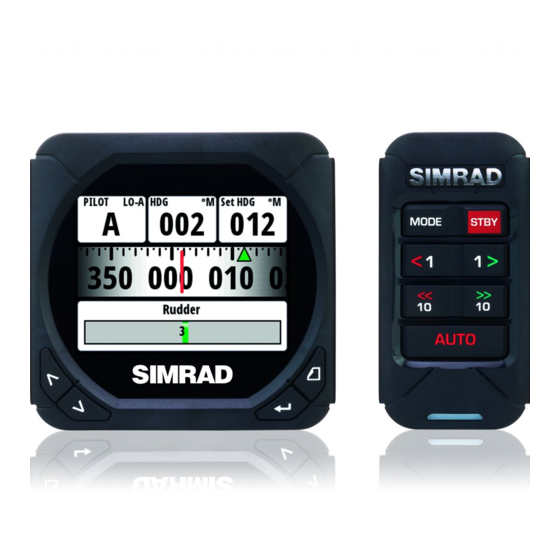Table of Contents
Advertisement
Advertisement
Table of Contents

Summary of Contents for Simrad IS40
- Page 1 IS40/Triton System Installation Manual ENGLISH...
- Page 2 Used to draw the reader’s attention to a comment or some important information. Warning: Used when it is necessary to warn personnel that they should proceed carefully to prevent risk of injury and/or damage to equipment/personnel. Preface | IS40/Triton System Installation Manual...
-
Page 3: About This Manual
Part 15.103 of the FCC rules. About this manual This manual is a reference guide for installing the Triton and IS40 system. The manual assumes that the installer has at very least, basic knowledge of DC electrical systems, and of working with power tools with materials such as fiberglass and wood. -
Page 4: Table Of Contents
Fitting with retention bracket Multiple displays Wiring Introduction to NMEA 2000 (SimNet) Daisy chaining the display Drop cable connection of the display Typical network example The SG05 EVC gateway Troubleshooting Spares & Accessories Technical Specifications Display Dimensional drawings Contents | IS40/Triton System Installation Manual... -
Page 5: Introduction
Introduction The Triton and IS40 Display utilizes a unique bonded 4.1-inch sunlight viewable LCD display to offer clearly read sailing information, including wind, speed, depth, heading, autopilot status, log, timer and much more. High contrast and a 155˚ viewing angle provide excellent readability, whilst the bonded display ensures there is no chance of condensation occurring regardless of the conditions. -
Page 6: Overview
OFF on some models. Changes the autopilot to Standby mode. Course control keys Changes target course / Activates Non Follow Up (NFU) mode when in Standby mode. Auto key Changes the autopilot to AUTO mode. Overview | IS40/Triton System Installation Manual... -
Page 7: Installation
Installation The IS40/Triton display may be mounted via a flush mounting clip or with the retention bracket attached to the rear of the unit. Choosing a location Choose the mounting locations carefully before you drill or cut. The display should be mounted so that the operator can easily use the controls and clearly see the display screen. -
Page 8: Fitting With Mounting Clip
- a positive ‘click’ should be felt when the display engages with the clip. Check that all four edges of the display make good contact with the mounting surface, and apply adequate compression to the gasket. Installation | IS40/Triton System Installation Manual... -
Page 9: Fitting With Retention Bracket
3.5 mm on each side when rotating for removal from the mounting clip. The absolute minimum space that should be allowed for each display is: • Width: 123 mm (4.84”) • Height: 120 mm (4.72”) Installation | IS40/Triton System Installation Manual... -
Page 10: Wiring
Wiring The IS40/Triton display can be connected to either an NMEA 2000 or SimNet network. There is no separate power cable, as the unit is powered from the network. There are two Micro-C connectors on each display, allowing for daisy chaining, which greatly increases the ease of connecting multiple displays that are in close proximity, and can save in cable weight and loom size. - Page 11 - the network may be affected by voltage drop when these devices are operated. Avoid connection to the engine starting batteries where possible. 10 | Wiring | IS40/Triton System Installation Manual...
-
Page 12: Daisy Chaining The Display
Drop cable connection of the display IS40/Triton Display Drop cable ¼ Note: For SimNet backbone a SimNet to Micro-C adapter cable must be used (part no. 24005729) NMEA 2000 backbone Micro-C T-connectors | 11 Wiring | IS40/Triton System Installation Manual... -
Page 13: Typical Network Example
• Daisy-chaining, as shown in this illustration, is recommended for ease of installation. It will still be compatible with most NMEA 2000 devices but not fully comply with NMEA 2000 standard. 12 | Wiring | IS40/Triton System Installation Manual... -
Page 14: The Sg05 Evc Gateway
Note that rudder angle data is sourced from the EVC system and a seperate rudder angle indicator is not required. IS40/Triton system SimNet to Micro-C adapter cable SD05 SimNet - Volvo Gateway Volvo Gateway (p.no. 000-1-258-001) | 13 Wiring | IS40/Triton System Installation Manual... -
Page 15: Troubleshooting
• Check network topology and termination rules are correctly implemented. • Disconnect other devices from network, one-by-one, starting with 3rd party devices. 14 | Troubleshooting | IS40/Triton System Installation Manual... -
Page 16: Spares & Accessories
000-10647-001 Wind sensor pack with 35 meter mast cable 000-10613-001 RC42N, Rate compass, micro-c 000-10614-001 Cable, micro-c, right angle interconnect Sun cover, display SimNet cable to Micro-C. Adapter cable for 24005729 SimNet products in an NMEA 2000 network | 15 Spares & Accessories | IS40/Triton System Installation Manual... -
Page 17: Technical Specifications
White (day mode) / Red Illumination (night mode) Environmental Protection IPX7 Safe distance to compass 0.3 m (1.0 ft.) Temperature Operating 0 to +55 ºC (+32 to +130 ºF) Storage -30 to +70 ºC (-22 to +158 ºF) 16 | Technical Specifications | IS40/Triton System Installation Manual... -
Page 18: Dimensional Drawings
Dimensional drawings Display 123 mm (4.84") 118 mm (4.64") Suncover outline 17 mm (0.67") 18.9 mm (0.74") 90 mm (3.54") | 17 Technical Specifications | IS40/Triton System Installation Manual... - Page 19 Autopilot controller 65 mm (2.5") 60 mm (2.4") Suncover outline 18 mm (0.7") 88 mm (3.5") 15 mm (0.6") 18 | Technical Specifications | IS40/Triton System Installation Manual...










Need help?
Do you have a question about the IS40 and is the answer not in the manual?
Questions and answers